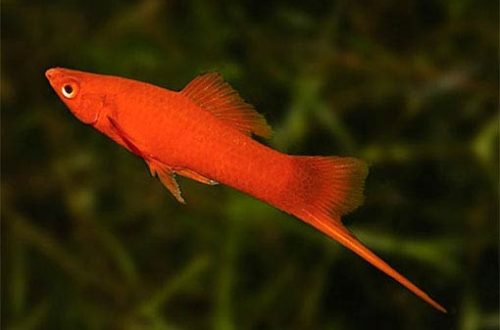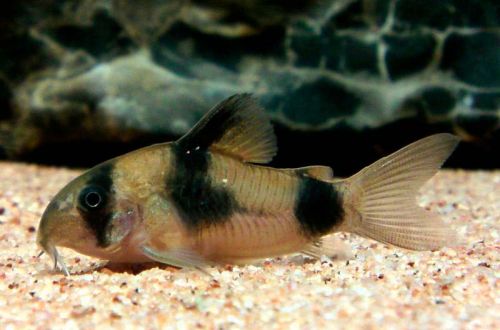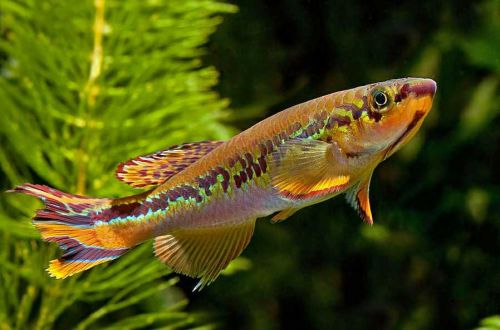
Striped panhax
Striped Panhax or Striped Asian pike, scientific name Aplocheilus lineatus, belongs to the family Aplocheilidae. In its natural form, a very attractive fish with an original body pattern, but the focus is on its breeding form in a rich golden color (in the images below). The combination of bright colors and low maintenance has made the Striped Panhax a popular fish among aquarists around the world. Can be recommended for beginners as a first fish.

It is worth remembering that the Striped Panhax is a real predator despite its modest size (an adult reaches about 10 cm), so the choice of aquarium neighbors is limited. All small species up to 4–5 cm will be considered as potential prey.
Habitat
It is widely distributed throughout the Hindustan Peninsula (the territory of modern India). They prefer all types of slow-moving or stagnant water, including brackish ones. Unlike most other species in this region, the Asian striped pike does not migrate, but lives permanently in its range. In a number of regions of India and neighboring states, they are used by local authorities as a means of combating mosquitoes. They feed on insect larvae, small aquatic insects, crustaceans, river worms, and small fish. The golden breeding form does not occur in the wild.
Description
A small slender fish, has an elongated body with a slightly arched back. The head is pointed with a slight flattening on top. The dorsal fin is located closer to the tail, both are rounded, the anal and ventral fins are pointed.
The natural coloration is copper-colored with bright yellow stripes throughout the body, however, in most cases, a selective form of golden color is found. There are also forms with a red tail, white fins, and other color variations.
Food
The striped Panhax is primarily a carnivore, so meat should form the basis of its diet. In the absence of the possibility of serving live food, it is permissible to use freeze-dried or frozen food from daphnia, bloodworms, insect larvae or pieces of fish, shrimp, worms, etc.
Maintenance and care
Quite unpretentious and at the same time sloppy. Fish will not pick up food that falls past them or lies on the ground. This can cause serious contamination, so an efficient filter and a 30% water change every two weeks is a must. Other important equipment, in addition to the filter, also includes an aerator, a heater, and a lighting system. Having a lid on the aquarium will prevent fish from accidentally jumping out. It successfully tolerates brackish water at a concentration of 2-3 teaspoons of sea salt (without a slide) per 10 liters.
The design welcomes a dark substrate of fine gravel, subdued lighting. Plants are arranged in groups along the side walls of the tank, and bunches of floating plants are of no small importance, in addition, they provide additional shading.
Social behavior
Compatible with other species as long as they are not very small such as Neons, Danios and others, as fish less than 5 cm in size will be perceived as food. There will be constant skirmishes between representatives of their species, they will not be able to get along together, therefore it is advisable to keep only one pair of Striped Panhaxes in the aquarium.
Breeding / breeding
Males differ from females in having pointed anal and pelvic fins. Spawning can be carried out in a common aquarium, Java moss is preferable as a substrate, it is on it that eggs will be laid. The breeding season can last several weeks, while during the day the couple can release up to 300 eggs.
The substrate from plants with eggs should be removed from the main aquarium and placed in a reserve tank with identical water parameters. The fry appear in 12–14 days, at first they will feed on the remnants of the yolk and only then will they switch to specialized products (microfood, ciliates, artemia). The water should be renewed regularly, food leftovers quickly lead to contamination. Some fry grow faster than others, after reaching a certain size, they can eat their fellows, so the largest individuals should be planted.
Diseases
Hardy, disease outbreaks are extremely rare in a balanced aquarium. Problems can arise from significant deterioration in water quality, contact with sick fish, injuries, etc. For more information on symptoms and treatments, see the Aquarium Fish Diseases section.





